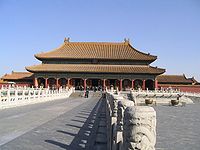
Palace of Heavenly Purity
Encyclopedia

Forbidden City
The Forbidden City was the Chinese imperial palace from the Ming Dynasty to the end of the Qing Dynasty. It is located in the middle of Beijing, China, and now houses the Palace Museum...
in Beijing
Beijing
Beijing , also known as Peking , is the capital of the People's Republic of China and one of the most populous cities in the world, with a population of 19,612,368 as of 2010. The city is the country's political, cultural, and educational center, and home to the headquarters for most of China's...
, China
China
Chinese civilization may refer to:* China for more general discussion of the country.* Chinese culture* Greater China, the transnational community of ethnic Chinese.* History of China* Sinosphere, the area historically affected by Chinese culture...
. It is the largest of the three halls of the Inner Court (the other two being the Hall of Union
Hall of Union
The Hall of Union is a building in the Forbidden City, in Beijing, China. It stands between the Palace of Heavenly Purity and the Palace of Earthly Tranquility. These three halls together constitute the centre of the Inner Court of the palace complex....
and the Palace of Earthly Tranquility
Palace of Earthly Tranquility
The Palace of Earthly Tranquility is the northernmost of the three main halls of the Inner Court of the Forbidden City, the other two halls being the Palace of Heavenly Purity and the Hall of Union....
), located at the northern end of the Forbidden City. During the Qing dynasty
Qing Dynasty
The Qing Dynasty was the last dynasty of China, ruling from 1644 to 1912 with a brief, abortive restoration in 1917. It was preceded by the Ming Dynasty and followed by the Republic of China....
, the palace often served as the Emperor's audience hall, where he held council with the Grand Council
Grand Council
The Grand Council or Junjichu was an important policy-making body in the Qing Empire. It was established in 1733 by the Yongzheng Emperor...
.
The Palace of Heavenly Purity is a double-eaved building, and set on a single-level white marble platform. It is connected to the Gate of Heavenly Purity to its south by a raised walkway. In the Ming Dynasty, it was the residence of the Emperor. The large space was divided into nine rooms on two levels, with twenty-seven beds. For security, on any one night the Emperor would randomly choose from any of these beds. This continued through the early Qing Dynasty. However, when the Yongzheng Emperor
Yongzheng Emperor
The Yongzheng Emperor , born Yinzhen , was the fifth emperor of the Manchu Qing Dynasty and the third Qing emperor from 1722 to 1735. A hard-working ruler, Yongzheng's main goal was to create an effective government at minimal expense. Like his father, the Kangxi Emperor, Yongzheng used military...
ascended to the throne, he did not wish to inhabit the palace occupied by his father
Kangxi Emperor
The Kangxi Emperor ; Manchu: elhe taifin hūwangdi ; Mongolian: Энх-Амгалан хаан, 4 May 1654 –20 December 1722) was the fourth emperor of the Qing Dynasty, the first to be born on Chinese soil south of the Pass and the second Qing emperor to rule over China proper, from 1661 to 1722.Kangxi's...
for sixty years. He and subsequent emperors lived instead at the smaller Hall of Mental Cultivation to the west. The Palace of Heavenly Purity then became the Emperor's audience hall, where he held court, received ministers and emissaries, and held banquets. At the centre of the Palace, set atop an elaborate platform, is a throne and a desk, on which the Emperor wrote notes and signed documents during councils with ministers. A caisson is set into the roof, featuring a coiled dragon.
Above the throne hangs a tablet with a right-to-left script "正大光明" (zhèng dà guāng míng), penned by the Shunzhi Emperor
Shunzhi Emperor
The Shunzhi Emperor was the third emperor of the Manchu-led Qing dynasty, and the first Qing emperor to rule over China, which he did from 1644 to 1661. "Shunzhi" was the name of his reign period...
. This tablet has been translated several ways. It is often used as a Chinese Idiom, meaning "To be decent, honest and magnanimous," or "to have no secret or do a shameless deed."
From the Yongzheng Emperor onwards, the Emperor designated his heir in secret, with one copy of the will hidden behind this tablet and another carried at all times by the Emperor.

